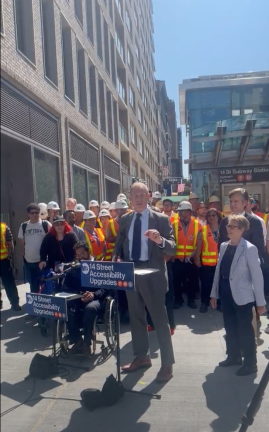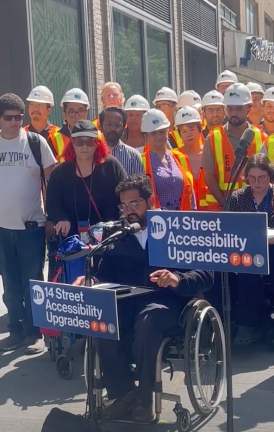Three New Accessible Elevators Now Link to 14th St.’s F, M, & L Subway Lines
The three new elevators will ferry riders to the 6th Ave. L and uptown F & M platforms. Three more elevators for the downtown F & M platform will open by the end of the year. At an August 22 opening ceremony, MTA CEO Janno Lieber said that the improvements would provide transit accessibility for 30,000 daily riders.
Three new elevators have opened at the 14th St./6th Ave. station, the MTA has announced, and will provide greater access for the 30,000 riders that use the station’s F, M and L stops every day.
The MTA is under a federal mandate to render 95 percent of its stations accessible by 2055, after it settled a class action lawsuit in 2022.
The agency says that one elevator will bring users from the street-level to the station’s mezzanine, one will connect users from the mezzanine to the uptown F and M platform, and one will connect users from the mezzanine to the all-directions L platform. The agency added that three additional elevators, which will provide similar accessibility to the station’s downtown F & M platform, are still in the works and will open later this year.
The entire 14th St. overhaul is being conducted with substantial federal funding, to the tune of $250 million. That’s 80 percent of its total cost. As Lieber put it: “This is a megaproject.”
As to whether future construction will cause diversions, similar to the 2023 shuttering of the station’s passageway 6th and 7th Avenue, the MTA said that they didn’t anticipate too much trouble.
“The MTA is not currently planning any additional long-term closures [at the station],” an MTA spokesperson told Straus News. “However, there will be sporadic weekend diversion closures, which won’t last longer than 55 hours (late Friday night to early Monday morning).”
The MTA head was joined at the opening event by MTA Chief Accessibility Officer Quemuel Arroyo, as well as State Senator Brad Hoylman-Sigal and State Assembly Member Deborah Glick. They spoke in front of the street-level elevator, not to mention an impressive crowd of MTA workers, all bedecked in their hi-vis gear and helmets.
“Part of the challenge we always face with accessibility is that our system is old! The different parts of this station have been around anywhere from 80 to 100-plus years,” Lieber said. “So it goes without saying that bringing all of this infrastructure into the 21st century is not easy, and it ain’t cheap, and it’s really complicated from an engineering standpoint.”
“Our subway forebears, who we bless everyday for what they did to create this amazing system, didn’t think about accessibility. We’re still struggling with it,” he added.
While people with disabilities will massively benefit from the new elevators, Lieber noted, they will also make life easier for a wider group of people; he said that this could include parents with strollers, seniors, and people that have lots of shopping bags.
Arroyo, the Chief Accessibility Officer, called the 14th St. megaproject “incredibly important.”
”14th St. has so much to offer, and this project will unlock so many destinations and new trips for our customers. None of this would be possible without our federal and state partners,” he added.
Arroyo also made brief reference to the fact that some of the MTA’s other accessibility projects have been impacted by the pause of congestion pricing, which blew a $15 billion hole in the MTA’s capital plan (specifically, an anticipated $1 billion in annual toll revenue evaporated). He hinted that the agency was counting on Albany to help close that newly created budget gap.
When it came time for her speech, Assembly Member Glick made reference to the ways in which disability can be universal: “Let’s be clear. We are all just temporarily able-bodied. At some point, through aging or some accident, all of us may need to be able to access this great system through elevators.”
“I’m happy that, under Lieber’s leadership, the battle days are gone when folks with disabilities–who couldn’t access a subway–were just the ‘cost of doing business,” Holyman-Sigal said, during his time at the mic. “There is a fundamental right to access mass transit.”

